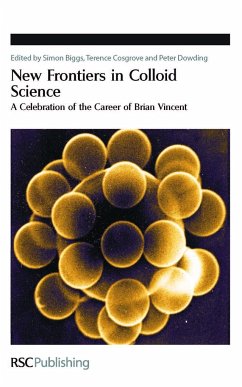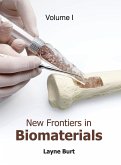New Frontiers in Colloid Science
A Celebration of the Career of Brian Vincent
Herausgeber: Biggs, Simon; Dowding, Peter; Cosgrove, Terence
New Frontiers in Colloid Science
A Celebration of the Career of Brian Vincent
Herausgeber: Biggs, Simon; Dowding, Peter; Cosgrove, Terence
- Gebundenes Buch
- Merkliste
- Auf die Merkliste
- Bewerten Bewerten
- Teilen
- Produkt teilen
- Produkterinnerung
- Produkterinnerung
This book offers an account of the career of Brian Vincent and an autobiographical summary of his impact on the field. Some of the topics covered include: The Adsorption of Small, Negative Particles onto Large Positive Particles; Polymer Chemistry, Hypervelocity Physics and the CASSINI Space Mission; The BV Droplets Downunder: From Model Emulsions to Drug Delivery; Polymers and Surfactants at Interfaces; Controlled Release as Desorption from Porous Polymeric Systems; Characterisation and Application of Colloidal Microgels and Surface Modification. Brian Vincent is a recognised expert in the…mehr
Andere Kunden interessierten sich auch für
![New Frontiers in Nanotechnology New Frontiers in Nanotechnology]() New Frontiers in Nanotechnology122,99 €
New Frontiers in Nanotechnology122,99 €![What a Coincidence! What a Coincidence!]() Bernhard WeßlingWhat a Coincidence!25,99 €
Bernhard WeßlingWhat a Coincidence!25,99 €![New Frontiers in Signal Processing New Frontiers in Signal Processing]() New Frontiers in Signal Processing135,99 €
New Frontiers in Signal Processing135,99 €![Frontiers of Reliability Frontiers of Reliability]() Asit P BasuFrontiers of Reliability88,99 €
Asit P BasuFrontiers of Reliability88,99 €![Frontiers of Computer Science and Information Technology Frontiers of Computer Science and Information Technology]() Frontiers of Computer Science and Information Technology166,99 €
Frontiers of Computer Science and Information Technology166,99 €![New Frontiers in Biomaterials New Frontiers in Biomaterials]() New Frontiers in Biomaterials142,99 €
New Frontiers in Biomaterials142,99 €![Frontiers of Multifunctional Integrated Nanosystems Frontiers of Multifunctional Integrated Nanosystems]() Eugenia V. Buzaneva / Peter Scharff (Hgg.)Frontiers of Multifunctional Integrated Nanosystems226,99 €
Eugenia V. Buzaneva / Peter Scharff (Hgg.)Frontiers of Multifunctional Integrated Nanosystems226,99 €-
-
-
This book offers an account of the career of Brian Vincent and an autobiographical summary of his impact on the field. Some of the topics covered include: The Adsorption of Small, Negative Particles onto Large Positive Particles; Polymer Chemistry, Hypervelocity Physics and the CASSINI Space Mission; The BV Droplets Downunder: From Model Emulsions to Drug Delivery; Polymers and Surfactants at Interfaces; Controlled Release as Desorption from Porous Polymeric Systems; Characterisation and Application of Colloidal Microgels and Surface Modification. Brian Vincent is a recognised expert in the field, and this book will have a specific appeal to colloid scientists both in academia and industry.
Produktdetails
- Produktdetails
- Verlag: RSC Publishing
- Seitenzahl: 212
- Erscheinungstermin: 24. Juli 2008
- Englisch
- Abmessung: 242mm x 162mm x 24mm
- Gewicht: 477g
- ISBN-13: 9780854041138
- ISBN-10: 0854041133
- Artikelnr.: 23806534
- Herstellerkennzeichnung
- Libri GmbH
- Europaallee 1
- 36244 Bad Hersfeld
- gpsr@libri.de
- Verlag: RSC Publishing
- Seitenzahl: 212
- Erscheinungstermin: 24. Juli 2008
- Englisch
- Abmessung: 242mm x 162mm x 24mm
- Gewicht: 477g
- ISBN-13: 9780854041138
- ISBN-10: 0854041133
- Artikelnr.: 23806534
- Herstellerkennzeichnung
- Libri GmbH
- Europaallee 1
- 36244 Bad Hersfeld
- gpsr@libri.de
Peter J Dowding, a Fellow of the Royal Society of Chemistry, is Principal Scientist at Infineum UK Limited an Exxon & Shell joint venture. He is leader for all background and fundamental studies of colloidal additives for future generations of additives used in lubricants and his research interests include: Surfactant Stabilised Nanoparticles, Steric Stabilisation, Surfactancy, Controlled Release, Supercritical Fluids and Properties of Asphaltenes. Terence Cosgrove is Professor at the School of Chemistry, University of Bristol. Simon Biggs is Professor of Particle Science and Engineering, Institute for Particle Science and Engineering, The University of Leeds and is a Fellow of the Royal Society of Chemistry, a member of the American Chemical Society, the International Association of Colloid and Interface Scientists, and the Royal Australian Chemical Society. His main research interests are in the field of colloid and interface science and he is recognised as a pioneer in the application of atomic force microscopy to the study of colloid and particle science. A significant number of his published papers were the first of their kind in the open literature - especially the work on the influence of polymers and surfactants on inter-particle forces.
Foreword
1- A Journey through Colloid Science
Early Days
Novel Colloidal Systems
Particle Synthesis
Particles with terminally-grafted polymer chains
Electrically -conducting particles
Microemulsions based on block or graft copolymers
Monodisperse Liquid Droplets
Liquid core / solid shell particles
Microgel Particles
Particle Interactions
Electrostatic interactions
Polymers at interfaces and steric interactions
Depletion interactions
Interactions in mixed particle systems
Deposition of particles on flat surfaces
Final Remarks
References
2- Synthesis of Poly-N-Isopropylacrylamide microgel particles containing gold nanoshell cores with potential for triggered de-swelling
Abstract
Introduction
Materials and Methods
Preparation of silica particles
Preparation of positively charged silica particles
Preparation of Gold nanoparticles
Attachment of gold nanoparticles to silica cores
Growth of gold nanoshells
Synthesis of hydrogel-coated gold or gold nanoshells
Results and Discussion
Adsorption of Gold nanoparticles onto positively charged silica particles
Concluding Remarks
References
3- Polymer Chemistry, Hypervelocity Physics and the CASSINI Space Mission
Introduction
Organic conducting polymers
Synthesis and properties of polypyrrole
Hypervelocity acceleration experiments
Do plasma mass spectra originate from the latex core or shell? Kinetic energy of a hypervelocity impact
The CASSINI space mission and the CDA adaptor
Four classes of micrometeorites
What is the nature of the volcanic activity on Io? Latex mimics for sulphur-rich micrometeorites
Conclusions
4- From Novel Monodisperse "Silicone Oil"/Water Emulsions to Drug Deliver
Abstract
Background
Introduction
Interaction Forces and Deformation of PDMS Droplets
Rheological Behavior of concentrated emulsions of PDMS Droplets
Polymers at Silicone Droplets Interfaces
Nanoparticles at PDMS Droplets
Towards a drug delivery system
Conclusions
Acknowledgements
References
5- Polymers and surfactants at interfaces: colloidal lego for nanotechnology
Introduction
Self-assembly of block copolymers and the formation of "smart colloids"
Adsorption of block copolymer micelles at the aqueous/ solid interface
Responsive and functional surfaces
Multilayer coatings, particles and capsules
Conclusions
Acknowledgements
References
6- Polymer depletion: recent progress for polymer/colloid phase diagrams
Abstract
Introduction
Theory
System and system parameters
Thermodynamics
Some illustrations
Results
Concluding remarks
References
7- NanoBubbles, dissolved gas, boundary layers and related mysterious effects in colloidal stability
Abstract
Introduction
Results and Discussion
Stability ratio as a function of dissolved gas and hydrophobicity
Colloid Stability Analysis
TMAFM Imaging
Images of Bubble Coalescence
Nature of Domains
Bubble Formation on Solid-Water Interfaces
Contact angles and line tension
Kinetics of CO2 gas adsorption using the QCM
Conclusions
Acknowledgement
References
8- Heteroflocculation studies of colloidal poly(N-isopropylacrylamide) microgels with polystyrene latex particles: effect of particle size, temperature and surface charge
Abstract
Introduction and background
Heterflocculation studies
Experimental
Microgel synthesis
Dry weight analysis
Preparation of anionic polystyrene latex and cationic microgel mixed dispersions
Dynamic light scattering (DLS)
Electrophoretic mobility and zeta potential measurements
Turbidimetric analysis
Scanning electron microscopy (SEM)
Results and Discussion
Scanning electron microscopy (SEM)
Characterisation of anionic PS latex particles
Heteroflocculation of microgel-latex mixtures
Concluding remarks
9- Surface Modification, Encapsulation and Coating- A Career built on Graft
Abstract
The early years: Colloid science, zeta potential and polymers
The dark side: Black boxes, sunscreens and hope-in-a-bottle
Back to the future: Colloid science, vaccines, microbicides and HIV/ AIDS
Conclusions
Acknowledgements
References
1- A Journey through Colloid Science
Early Days
Novel Colloidal Systems
Particle Synthesis
Particles with terminally-grafted polymer chains
Electrically -conducting particles
Microemulsions based on block or graft copolymers
Monodisperse Liquid Droplets
Liquid core / solid shell particles
Microgel Particles
Particle Interactions
Electrostatic interactions
Polymers at interfaces and steric interactions
Depletion interactions
Interactions in mixed particle systems
Deposition of particles on flat surfaces
Final Remarks
References
2- Synthesis of Poly-N-Isopropylacrylamide microgel particles containing gold nanoshell cores with potential for triggered de-swelling
Abstract
Introduction
Materials and Methods
Preparation of silica particles
Preparation of positively charged silica particles
Preparation of Gold nanoparticles
Attachment of gold nanoparticles to silica cores
Growth of gold nanoshells
Synthesis of hydrogel-coated gold or gold nanoshells
Results and Discussion
Adsorption of Gold nanoparticles onto positively charged silica particles
Concluding Remarks
References
3- Polymer Chemistry, Hypervelocity Physics and the CASSINI Space Mission
Introduction
Organic conducting polymers
Synthesis and properties of polypyrrole
Hypervelocity acceleration experiments
Do plasma mass spectra originate from the latex core or shell? Kinetic energy of a hypervelocity impact
The CASSINI space mission and the CDA adaptor
Four classes of micrometeorites
What is the nature of the volcanic activity on Io? Latex mimics for sulphur-rich micrometeorites
Conclusions
4- From Novel Monodisperse "Silicone Oil"/Water Emulsions to Drug Deliver
Abstract
Background
Introduction
Interaction Forces and Deformation of PDMS Droplets
Rheological Behavior of concentrated emulsions of PDMS Droplets
Polymers at Silicone Droplets Interfaces
Nanoparticles at PDMS Droplets
Towards a drug delivery system
Conclusions
Acknowledgements
References
5- Polymers and surfactants at interfaces: colloidal lego for nanotechnology
Introduction
Self-assembly of block copolymers and the formation of "smart colloids"
Adsorption of block copolymer micelles at the aqueous/ solid interface
Responsive and functional surfaces
Multilayer coatings, particles and capsules
Conclusions
Acknowledgements
References
6- Polymer depletion: recent progress for polymer/colloid phase diagrams
Abstract
Introduction
Theory
System and system parameters
Thermodynamics
Some illustrations
Results
Concluding remarks
References
7- NanoBubbles, dissolved gas, boundary layers and related mysterious effects in colloidal stability
Abstract
Introduction
Results and Discussion
Stability ratio as a function of dissolved gas and hydrophobicity
Colloid Stability Analysis
TMAFM Imaging
Images of Bubble Coalescence
Nature of Domains
Bubble Formation on Solid-Water Interfaces
Contact angles and line tension
Kinetics of CO2 gas adsorption using the QCM
Conclusions
Acknowledgement
References
8- Heteroflocculation studies of colloidal poly(N-isopropylacrylamide) microgels with polystyrene latex particles: effect of particle size, temperature and surface charge
Abstract
Introduction and background
Heterflocculation studies
Experimental
Microgel synthesis
Dry weight analysis
Preparation of anionic polystyrene latex and cationic microgel mixed dispersions
Dynamic light scattering (DLS)
Electrophoretic mobility and zeta potential measurements
Turbidimetric analysis
Scanning electron microscopy (SEM)
Results and Discussion
Scanning electron microscopy (SEM)
Characterisation of anionic PS latex particles
Heteroflocculation of microgel-latex mixtures
Concluding remarks
9- Surface Modification, Encapsulation and Coating- A Career built on Graft
Abstract
The early years: Colloid science, zeta potential and polymers
The dark side: Black boxes, sunscreens and hope-in-a-bottle
Back to the future: Colloid science, vaccines, microbicides and HIV/ AIDS
Conclusions
Acknowledgements
References
Foreword
1- A Journey through Colloid Science
Early Days
Novel Colloidal Systems
Particle Synthesis
Particles with terminally-grafted polymer chains
Electrically -conducting particles
Microemulsions based on block or graft copolymers
Monodisperse Liquid Droplets
Liquid core / solid shell particles
Microgel Particles
Particle Interactions
Electrostatic interactions
Polymers at interfaces and steric interactions
Depletion interactions
Interactions in mixed particle systems
Deposition of particles on flat surfaces
Final Remarks
References
2- Synthesis of Poly-N-Isopropylacrylamide microgel particles containing gold nanoshell cores with potential for triggered de-swelling
Abstract
Introduction
Materials and Methods
Preparation of silica particles
Preparation of positively charged silica particles
Preparation of Gold nanoparticles
Attachment of gold nanoparticles to silica cores
Growth of gold nanoshells
Synthesis of hydrogel-coated gold or gold nanoshells
Results and Discussion
Adsorption of Gold nanoparticles onto positively charged silica particles
Concluding Remarks
References
3- Polymer Chemistry, Hypervelocity Physics and the CASSINI Space Mission
Introduction
Organic conducting polymers
Synthesis and properties of polypyrrole
Hypervelocity acceleration experiments
Do plasma mass spectra originate from the latex core or shell? Kinetic energy of a hypervelocity impact
The CASSINI space mission and the CDA adaptor
Four classes of micrometeorites
What is the nature of the volcanic activity on Io? Latex mimics for sulphur-rich micrometeorites
Conclusions
4- From Novel Monodisperse "Silicone Oil"/Water Emulsions to Drug Deliver
Abstract
Background
Introduction
Interaction Forces and Deformation of PDMS Droplets
Rheological Behavior of concentrated emulsions of PDMS Droplets
Polymers at Silicone Droplets Interfaces
Nanoparticles at PDMS Droplets
Towards a drug delivery system
Conclusions
Acknowledgements
References
5- Polymers and surfactants at interfaces: colloidal lego for nanotechnology
Introduction
Self-assembly of block copolymers and the formation of "smart colloids"
Adsorption of block copolymer micelles at the aqueous/ solid interface
Responsive and functional surfaces
Multilayer coatings, particles and capsules
Conclusions
Acknowledgements
References
6- Polymer depletion: recent progress for polymer/colloid phase diagrams
Abstract
Introduction
Theory
System and system parameters
Thermodynamics
Some illustrations
Results
Concluding remarks
References
7- NanoBubbles, dissolved gas, boundary layers and related mysterious effects in colloidal stability
Abstract
Introduction
Results and Discussion
Stability ratio as a function of dissolved gas and hydrophobicity
Colloid Stability Analysis
TMAFM Imaging
Images of Bubble Coalescence
Nature of Domains
Bubble Formation on Solid-Water Interfaces
Contact angles and line tension
Kinetics of CO2 gas adsorption using the QCM
Conclusions
Acknowledgement
References
8- Heteroflocculation studies of colloidal poly(N-isopropylacrylamide) microgels with polystyrene latex particles: effect of particle size, temperature and surface charge
Abstract
Introduction and background
Heterflocculation studies
Experimental
Microgel synthesis
Dry weight analysis
Preparation of anionic polystyrene latex and cationic microgel mixed dispersions
Dynamic light scattering (DLS)
Electrophoretic mobility and zeta potential measurements
Turbidimetric analysis
Scanning electron microscopy (SEM)
Results and Discussion
Scanning electron microscopy (SEM)
Characterisation of anionic PS latex particles
Heteroflocculation of microgel-latex mixtures
Concluding remarks
9- Surface Modification, Encapsulation and Coating- A Career built on Graft
Abstract
The early years: Colloid science, zeta potential and polymers
The dark side: Black boxes, sunscreens and hope-in-a-bottle
Back to the future: Colloid science, vaccines, microbicides and HIV/ AIDS
Conclusions
Acknowledgements
References
1- A Journey through Colloid Science
Early Days
Novel Colloidal Systems
Particle Synthesis
Particles with terminally-grafted polymer chains
Electrically -conducting particles
Microemulsions based on block or graft copolymers
Monodisperse Liquid Droplets
Liquid core / solid shell particles
Microgel Particles
Particle Interactions
Electrostatic interactions
Polymers at interfaces and steric interactions
Depletion interactions
Interactions in mixed particle systems
Deposition of particles on flat surfaces
Final Remarks
References
2- Synthesis of Poly-N-Isopropylacrylamide microgel particles containing gold nanoshell cores with potential for triggered de-swelling
Abstract
Introduction
Materials and Methods
Preparation of silica particles
Preparation of positively charged silica particles
Preparation of Gold nanoparticles
Attachment of gold nanoparticles to silica cores
Growth of gold nanoshells
Synthesis of hydrogel-coated gold or gold nanoshells
Results and Discussion
Adsorption of Gold nanoparticles onto positively charged silica particles
Concluding Remarks
References
3- Polymer Chemistry, Hypervelocity Physics and the CASSINI Space Mission
Introduction
Organic conducting polymers
Synthesis and properties of polypyrrole
Hypervelocity acceleration experiments
Do plasma mass spectra originate from the latex core or shell? Kinetic energy of a hypervelocity impact
The CASSINI space mission and the CDA adaptor
Four classes of micrometeorites
What is the nature of the volcanic activity on Io? Latex mimics for sulphur-rich micrometeorites
Conclusions
4- From Novel Monodisperse "Silicone Oil"/Water Emulsions to Drug Deliver
Abstract
Background
Introduction
Interaction Forces and Deformation of PDMS Droplets
Rheological Behavior of concentrated emulsions of PDMS Droplets
Polymers at Silicone Droplets Interfaces
Nanoparticles at PDMS Droplets
Towards a drug delivery system
Conclusions
Acknowledgements
References
5- Polymers and surfactants at interfaces: colloidal lego for nanotechnology
Introduction
Self-assembly of block copolymers and the formation of "smart colloids"
Adsorption of block copolymer micelles at the aqueous/ solid interface
Responsive and functional surfaces
Multilayer coatings, particles and capsules
Conclusions
Acknowledgements
References
6- Polymer depletion: recent progress for polymer/colloid phase diagrams
Abstract
Introduction
Theory
System and system parameters
Thermodynamics
Some illustrations
Results
Concluding remarks
References
7- NanoBubbles, dissolved gas, boundary layers and related mysterious effects in colloidal stability
Abstract
Introduction
Results and Discussion
Stability ratio as a function of dissolved gas and hydrophobicity
Colloid Stability Analysis
TMAFM Imaging
Images of Bubble Coalescence
Nature of Domains
Bubble Formation on Solid-Water Interfaces
Contact angles and line tension
Kinetics of CO2 gas adsorption using the QCM
Conclusions
Acknowledgement
References
8- Heteroflocculation studies of colloidal poly(N-isopropylacrylamide) microgels with polystyrene latex particles: effect of particle size, temperature and surface charge
Abstract
Introduction and background
Heterflocculation studies
Experimental
Microgel synthesis
Dry weight analysis
Preparation of anionic polystyrene latex and cationic microgel mixed dispersions
Dynamic light scattering (DLS)
Electrophoretic mobility and zeta potential measurements
Turbidimetric analysis
Scanning electron microscopy (SEM)
Results and Discussion
Scanning electron microscopy (SEM)
Characterisation of anionic PS latex particles
Heteroflocculation of microgel-latex mixtures
Concluding remarks
9- Surface Modification, Encapsulation and Coating- A Career built on Graft
Abstract
The early years: Colloid science, zeta potential and polymers
The dark side: Black boxes, sunscreens and hope-in-a-bottle
Back to the future: Colloid science, vaccines, microbicides and HIV/ AIDS
Conclusions
Acknowledgements
References








